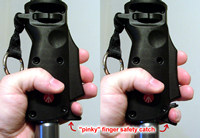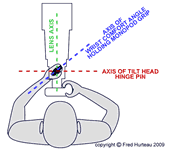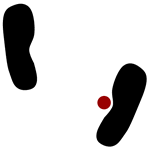 |
|
|
|

Manfrotto 685B NeoTec Monopod
and
Monopod Technique
|
 |
click
the
image for a
larger view
|
Introduction:
Monopods
can be a little frustrating until you get a handle on
how to use them. At least that was my experience the first
time I tried to steady my 500mm lens on my 685B NeoTec
monopod. With a little help from the internet, I found
some tips on better technique that I will share with you
farther on. First though, I want to talk about the monopod
I chose, and why I chose it.
I
had never considered getting a monopod before I bought
the Canon EF 500mm f/4 IS. Prior to that I shot nearly
everything hand-held. When I got the 500mm, I mostly used
it on a tripod with the Manfrotto 393 (3421) gimbal, which
made it very easy to handle while shooting. Still, it
was unwieldy to carry with tripod, gimbal and lens.
I
tried shooting with it hand-held a few times, which made
it painfully obvious that was not going to work out. If
you haven't tried it for yourself, you can easily find
out what it's like. Simply grab a full gallon of milk
by the handle and try holding it out at arm's length as
if you had a lens in front of you. Why, you can even use
both hands if you wish. If you can hold it out there for
a minute without getting the shakes, you won't need to
read this, because you won't need a monopod when you get
a big, long, heavy supertelephoto. I, on the other hand,
was going to need one for those occasions when dragging
along a tripod wasn't practical.
After using the lens with
a tripod, I knew I did not want to attempt holding ten
pounds of lens and camera on the end of a two-foot stick
with one hand while trying to turn it into a five-foot
stick with the other hand. My first concern was finding
a monopod that would be easy to handle with a Canon 500mm
f/4 IS on top of it. The Manfrotto 658B NeoTec monopod
turned out to be just what the doctor ordered. Read on
for my "review" of the 685B, or jump to the section on
Monopod Technique with
a heavy lens.
|
Maximum Height |
66.9" (169.9cm) |
| Folded
Length |
29.3"
(74.4cm) |
| Load
Capacity |
17.6
lbs (8kg) |
|
Leg Sections |
3 |
| Leg
Lock Type |
One-handed
automatic grip-action release |
| Male
Thread Size |
1/4"-20
& 3/8"-16 |
| Weight |
1.76 lbs (0.8kg) |
|
 |
| Grip
handle with release trigger and safety catch. |
|
Features of the 685B NeoTec:
The
685B weighs 1.7 pounds (0.8kg) and is rated for 17.6 pounds
load (8kg), enough to take on the 500mm, plus camera body,
plus head and clamp, plus my left arm draped over it for
stability and dampening. That doesn't mean this tripod
is solid as an oak tree with that much weight on it, but
technically it's supposed to at least handle that load
without failing (collapsing) [more on that farther
along]. The thing that drew me to this monopod is
it's unique design, which allows you to extend and collapse
it's full length with one hand - Yes, ONE HAND. It has
a small fold-out "pedal" that you simply hold down with
your toe as you pull up on the monopod to extend it. No
matter what height you stop at, it's automatically locked
in position and will not drop down - no clamps, clips,
catches, knobs or anything else to tighten. In fact, Manfrotto
claims that the more you push down on it, the tighter
it locks. You can keep pulling it up farther and farther
until it's fully extended without having to release anything.
When
it's time to adjust it lower, or to collapse it altogether,
that is also a one-handed operation. It has a squeeze
trigger in the top grip that must be squeezed to release
the lock, but that doesn't work unless you first squeeze
the "pinky finger" safety catch. So, to collapse it, you
squeeze your pinky finger on the safety catch, then squeeze
the large trigger with the rest of your fingers. The leg
sections then collapse until you stop squeezing, at which
point it instantly locks in place again, no matter what
height it's at. All in all it could hardly be simpler
or easier. This unique system allows me to keep my right
hand on the camera body grip so I am confident I have
the camera and lens under full control, while using my
left hand on the monopod grip to extend and collapse the
monopod. It provides a level of control and confidence
while handling such a large, heavy lens that I really
had not expected to find in a monopod.
Choosing A Head:
The
one-handed operation is not the only unique feature of
the 685B. Because it has a hand grip with trigger where
you would normally grasp a round shaft on other monopods,
holding it and setting up the head will differ as well.
At this point I need to explain my reasoning for selecting
a tilt head as opposed to a ball head or gimbal head for
the monopod.
- A gimbal head would be the best solution for a large
lens, even on a monopod, period. The gimbal head is
designed to let you release the camera and lens completely
without fear of the dreaded catastrophic "lens flop"
from an unbalanced load. On a tripod, everything would
stay put if you let go completely, but on a monopod,
the monopod itself would fall over - the mother of
all catastrophic "lens flops" (monopod and all). The
fact is you're simply not going to let go of the lens
and camera on a monopod unless you have hold of the
monopod itself.
- Essentially, I think of this as using the camera
"hand-held" while on the monopod. I treat it as if
it's hand-held because I will have hold of it at all
times. The only purpose for the monopod is to defeat
gravity and take the weight of the lens while I shoot
in a "hand-held" mode.
- The gimbal would allow for vertical tilt and horizontal
panning. Since the monopod itself is essentially a
pivot point for horizontal panning, the horizontal
function of the gimbal is unnecessary, and thus the
extra weight of a gimbal is unnecessary as well.
- Without the gimbal, the only thing missing from
the monopod is a sufficient range of vertical tilt,
so the simple solution for that is a lightweight one
axis tilt head. If you used a ball head in the place
of a tilt head, you're back to having a wobbly head
that could flop in any direction, making handling
all the more precarious. With a tilt head, any possible
flop is limited to only one direction, which simplifies
the equation.
- A good tilt head is much lighter and less expensive
than either a ball head or gimbal.
 |
For
all these reasons I chose a single axis tilt head. For
more information on the specific head and QR clamp/plate
I use on this monopod, read my mini-review.
Now click the illustration at right for an enlarged image
and look at the three axis angles depicted. For a tilt
head to work properly, its tilt axis must be at a right
angle to the lens axis. That's pretty easy to understand.
With the trigger grip on the 685B monopod, you need to
take one more thing into consideration. Holding the trigger
grip in a comfortable position for your wrist angles the
grip about half way between the tilt axis and the lens
axis, at about 45 degrees. So, the tilt head should be
mounted and tightened at this angle. If this monopod was
simply round at the top it wouldn't matter how it was
turned when attaching the tilt head, but with the grip
there shaped to fit your hand, this is the angle you will
find yourself holding it at.
Pros and Cons:
For
the "on-the-move" photographer, the one-handed ease of
extending and collapsing the NeoTech monopod has to be
the number one reason for using it. No other monopod I
know of comes close. Other than the fact it had to be
load rated to handle the weight of the 500mm lens, its
ease of use was the major reason I chose it. The lens
is enough of a challenge to handle without fighting with
leg locks as well. I simply cannot imagine trying to deal
with such a large lens on any monopod with leg locks.
Another
point to consider is length, both collapsed and extended.
The specs say full extension is 66.9 inches. My tape measure
says 67.1. Anyway, with the tilt head and QR clamp installed,
that raises it to 70.3 inches. Add the 500mm lens with
camera mounted and my 50D eyepiece comes to 74.5 inches.
That's eye level for someone who stands 6' 5", a foot
taller than I need. On the opposite end of the scale,
the collapsed length is a longish 29.3 inches. Many say
it's too long to pack for flying and travel, a valid point
for many folks. Since I only use this monopod with the
500mm lens, it's not a problem for me because the 500mm
is too big to consider flying with in any event. The nearly
30-inch length actually makes it easier for me to fully
collapse the monopod almost without even bending at the
waist.
The
three leg sections are in reverse order, that is, smallest
diameter tube at the top and largest diameter at the bottom.
I can only guess it's because of the design of the internal
locking mechanism. While there is a tiny bit of flex in
the legs fully extended, you have to intentionally wiggle
the monopod to notice it. It's no more than is to be expected
of any monopod with tubes of a smallish diameter like
this one. However, there is another flex point - inside
the grip handle, which is made in two halves screwed together
(obviously there had to be some way to assemble the squeeze
triggers inside the handle). You may never notice this
flex with a smaller lens on the monopod, but the weight
of the 500mm makes this flex more easily noticed, and
probably more pronounced.
While
the bit of "flex" in this unit would be utterly
unacceptable on a tripod, you must remember this is not
a tripod. For my purposes, namely using it to take the
weight of the lens so I can shoot in a virtual "hand-held"
mode, the flex is not an issue. WIth or without a monopod,
you're going to get movement when shooting hand-held.
Having image stabilization on the lens will make up for
any flex just as it does for body motion when shooting
hand-held.
Even
these "cons" cannot dissuade me from the major merit of
the NeoTec monopod - namely, the one-handed extension
and collapse, with no leg-locks to deal with. I cannot
emphasize enough what a handful the 500mm lens is to handle,
whether hand-held, on a monopod, or on a tripod. Any monopod
that actually makes this task easier gets my vote. I hope
no one really expects any monopod to be as steady as a
tripod though. For that reason I had never even considered
using a monopod until I'd had my 500mm for over a year.
I found myself wishing for something that could take its
weight out of the equation when trying to use it "hand-held"
as I was so used to doing with my other lenses. I wanted
that freedom with the 500mm, and the 685B NeoTech monopod
has provided it. The only issue for me was that the monopod
hold the weight of the lens while NOT adding hassle to
handling the lens. For me, the one-handed operation of
the NeoTech monopod does this admirably. (For some
additional thoughts and insights on the NeoTec monopod,
you should also read through my "mini-review"
of it, as well as my related article on a safety
cable for the monopod foot.)
 |
A
scene from the Monopod Technique video
|
 |
Foot
pattern of my
chosen monopod stance
while holding
the
monopod leg snug
against my right leg |
Monopod Technique:
Using
a monopod with a large telephoto lens will take some experimentation
with various stances to find a good balance and comfortable
posture. If you've looked over the two articles on my
"Tips" page, you've
seen several ways to stand and hold a monopod. I've found
that the stance pattern shown at right works for me with
the heavy bulk of a 500mm lens. It lets me keep my right
foot on the foot pedal so I can quickly pull the monopod
up higher when needed while keeping the monopod leg against
my thigh and stomach for stability. This sort of "hugging"
the monopod comes as close as anything to the feeling
of hand-holding a smaller lens while using the 500mm.
It takes away that "wobbly stick under the lens" feeling
that made my initial trials with the monopod so frustrating.
The monopod essentially becomes part of my body instead
of being this stick floating out there in front of me
with a huge lens teetering on top of it.
I
hold the camera grip with my right hand (pretty much the
only thing you can do there) while I use my left hand
in any of three ways.
(1) Left forearm
and wrist laying on top of the lens as I do to dampen
vibrations
with a tripod and gimbal
-- This gives
me the steadiest shot.
(2) Left hand
cupped under the front of the lens as I would if hand-holding
a lens
-- This makes
it easier to pan with a fast moving subject.
(3) Left hand
gripping the monopod grip
-- This is
good for scanning around while having the grip ready to
extend or lower the monopod quickly.
The 2-minute video (above
right) will demonstrate the technique I'm trying to describe.
You will also see how simple it is to adjust the NeoTec
monopod up and down. Shifting to high angle BIF shots
is a breeze - almost as easy as hand-held without a monopod
- and collapsing the monopod completely to move to your
next location is just as simple.
|
| |
|
|
 |
|
 |
